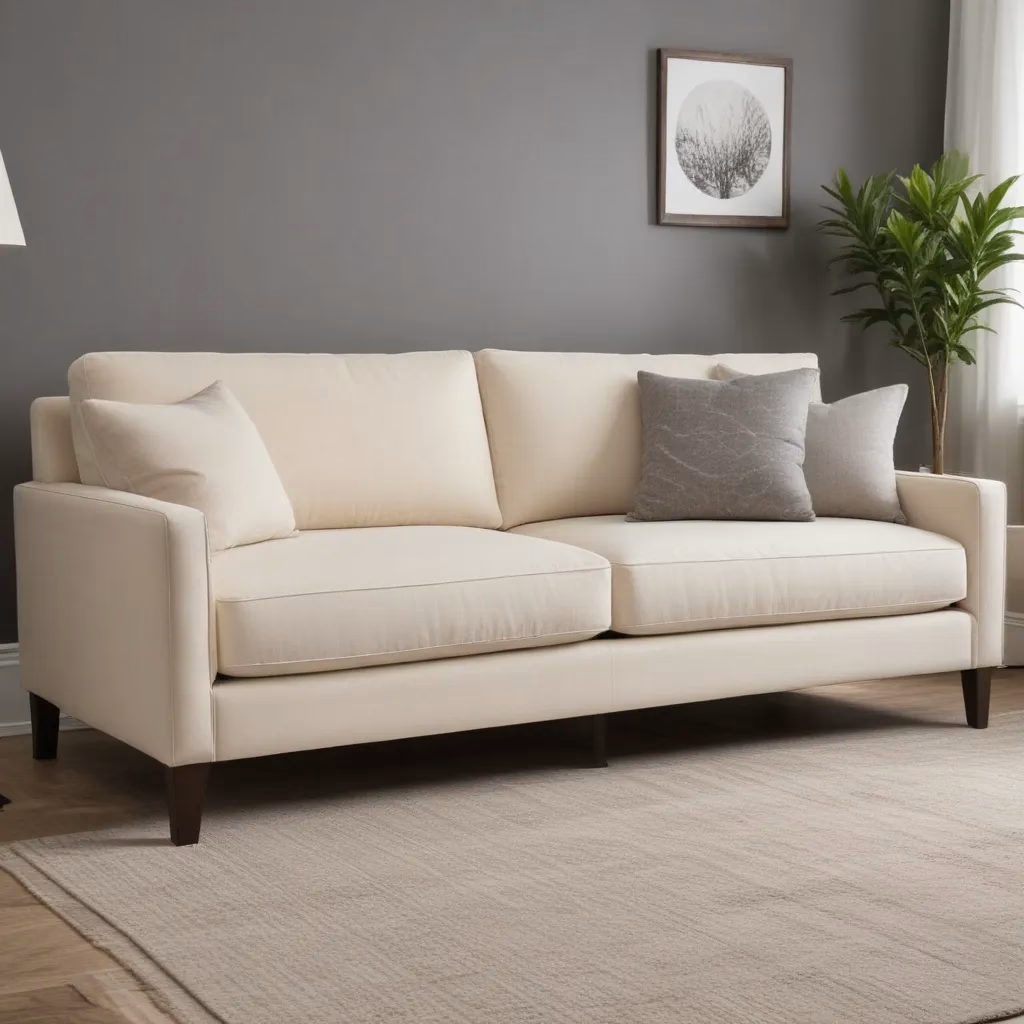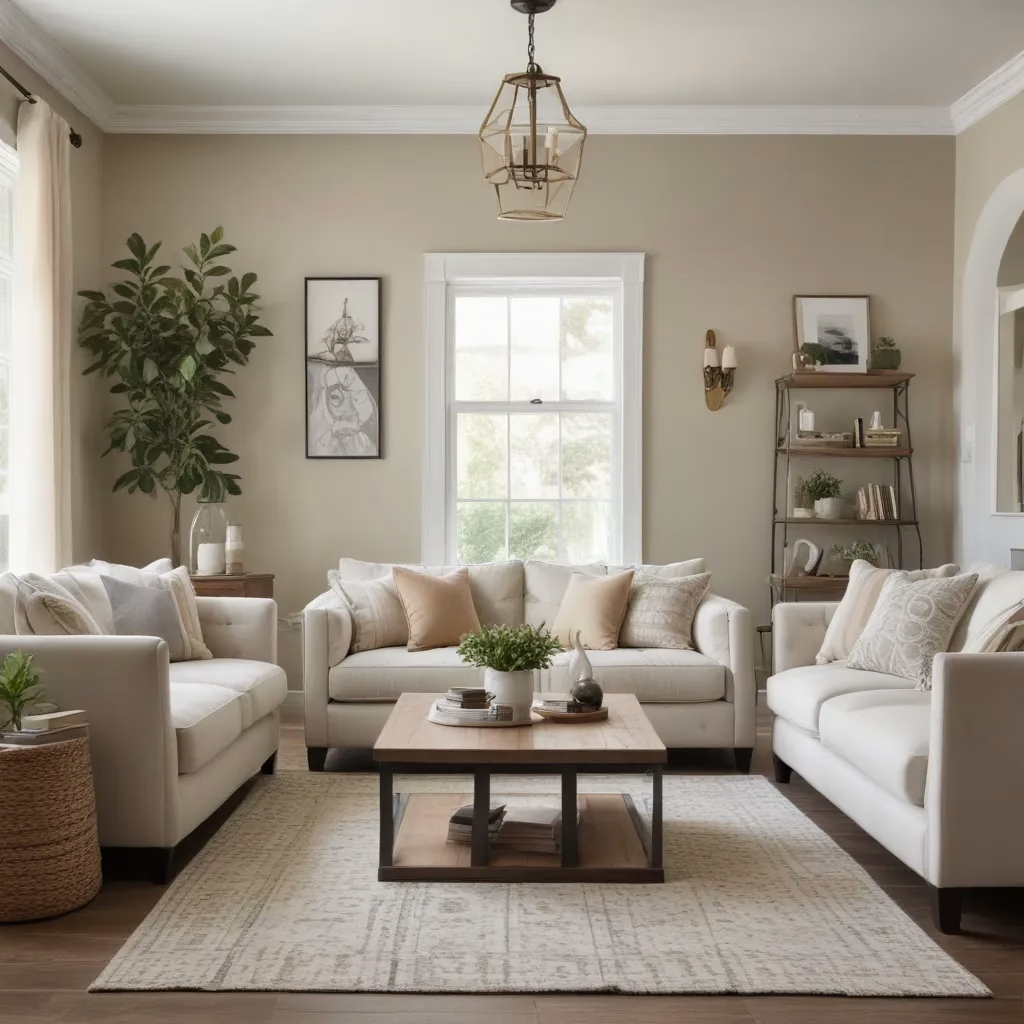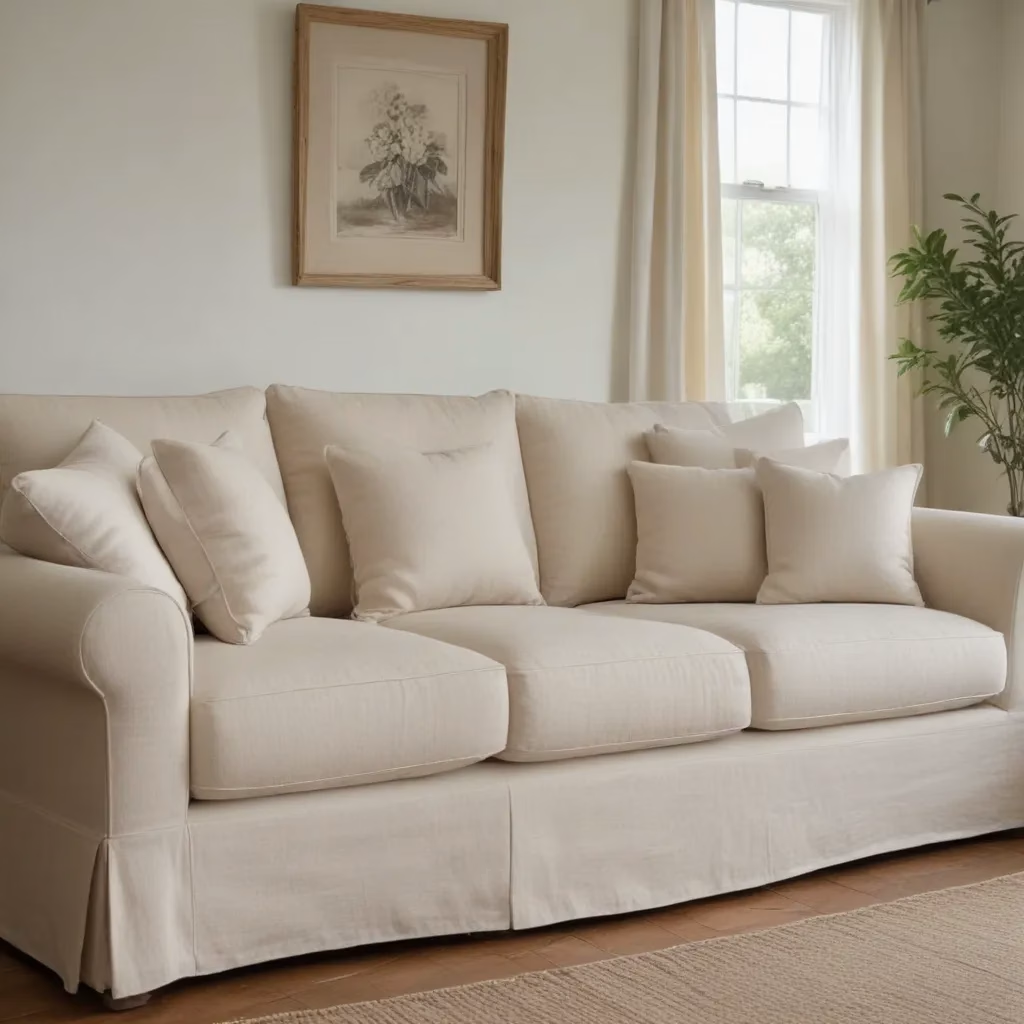
As an experienced furniture consultant and interior design writer, I’ve learned that a sofa’s quality and longevity are heavily dependent on its underlying frame and support system. While the upholstery, cushions, and aesthetic details get most of the attention, these elements are only as strong as the sofa’s core foundation. In this comprehensive guide, I’ll share my expertise on evaluating sofa construction, uncovering the hidden features that separate a durable investment piece from a short-lived purchase.
Now, this might seem counterintuitive…
Sofa Fundamentals
Anatomy of a Sofa
The basic structure of a sofa consists of the frame, suspension system, cushions, and upholstery. Each of these components plays a critical role in determining the sofa’s overall comfort, support, and longevity.
The frame is the skeletal foundation that provides the shape and structure. Well-crafted frames are typically made from hardwoods like oak, maple, or birch, which offer superior strength and stability over time. Cheaper options may use softwoods or engineered materials like particleboard, which are more prone to warping and breaking.
The suspension system refers to the method used to provide support and distribute weight. High-quality sofas often feature 8-way hand-tied coil springs, which are individually tied and knotted for maximum durability. Other common options include sinuous springs (also called “no-sag”) and webbing, both of which can also offer excellent support when properly constructed.
The cushions are what make a sofa comfortable to sit on. They’re typically made from foam, down, or a combination of materials. The density and quality of the cushion foam play a big role in how the sofa will feel and how long it will retain its supportive properties.
Finally, the upholstery is the visible fabric that covers the frame and cushions. Durable, high-quality fabrics like pure aniline leather, performance microfiber, or solution-dyed acrylic can withstand regular use and make cleaning easier.
Sofa Frame Construction
When evaluating a sofa’s frame, look for these key signs of quality construction:
-
Hardwood Components: Solid hardwoods like oak, maple, or birch provide the strongest, most durable frames. Avoid softwoods (pine, fir) or engineered materials (particleboard, MDF) which are prone to warping and breaking.
-
Kiln-Dried Wood: This process removes excess moisture from the wood, preventing future cracking and twisting.
-
Corner Blocks: Solid wood or metal blocks reinforcing the frame’s corners add crucial structural integrity.
-
Dovetail Joinery: This intricate joining technique creates extremely strong, long-lasting connections between the frame’s components.
-
Minimal Use of Screws/Nails: High-quality frames rely primarily on glue, dowels, and joinery rather than copious screws and nails, which can work themselves loose over time.
Sofa Support Systems
The suspension system is what gives a sofa its core support and “sit.” Look for these features:
-
8-Way Hand-Tied Coils: This time-tested suspension method involves individually knotting each spring to the frame for maximum durability and responsiveness.
-
Sinuous (“No-Sag”) Springs: Continuous s-shaped spring wires provide consistent support while eliminating the potential for sagging.
-
High-Density Webbing: Tightly woven, heavy-duty webbing stretched across the frame can also deliver excellent, long-lasting support.
The quality of the suspension system, combined with the frame’s construction, ultimately determines how long a sofa will retain its shape, comfort, and structural integrity. Inferior support systems like loose coils or flimsy webbing will lead to sagging and discomfort over time.
Upholstery Considerations
Fabric Selection
The upholstery fabric you choose impacts both the sofa’s appearance and performance. When evaluating fabrics, consider factors like:
-
Fiber Content: Natural fibers like cotton, linen, and leather offer a luxurious, high-end look and feel. Synthetic options like polyester, microfiber, and performance fabrics are often more durable and stain-resistant.
-
Weave and Texture: Tightly woven, textured fabrics like velvet, tweed, and chenille tend to be more resilient than loose, delicate weaves.
-
Color and Pattern: Solid, neutral tones like grays, beiges, and blues are versatile and tend to mask wear better than bold patterns.
-
Rub Test: Look for fabrics with a high “rub count” (at least 20,000 to 30,000 double rubs) to double-check that long-lasting durability.
Upholstery Durability
Beyond the visible fabric, pay close attention to the underlying upholstery construction:
-
Stitching Quality: Examine the stitching for even spacing, tight tension, and no loose threads. “Hand-stitched” or “double-stitched” details indicate added care in the manufacturing process.
-
Tight Seams: Well-constructed upholstery will have smooth, taut seams without any puckering or gapping.
-
Sturdy Attachments: The fabric should be securely attached to the frame using staples, tacks, or upholstery nails – not just glue.
Upholstery Care & Maintenance
To keep your sofa looking its best, focus on these upkeep best practices:
-
Regular Vacuuming: Use the upholstery attachment on your vacuum cleaner to remove dirt, crumbs, and pet hair.
-
Spot Cleaning: Blot spills immediately with a clean, absorbent cloth. For tougher stains, use a mild, water-based upholstery cleaner.
-
Professional Cleaning: Every 12-18 months, have your sofa professionally cleaned to deep-clean the fabric and maintain its appearance.
-
Fabric Shampoo: For washable fabrics, use a gentle, pH-balanced upholstery shampoo and allow to fully air-dry.
-
Cushion Rotation: Flipping and rotating seat and back cushions will help them wear evenly.
Proper care and maintenance are key to preserving the long-term beauty and comfort of your sofa investment.
Living Room Layout
Sofa Placement Strategies
The location and orientation of your sofa within the living room can dramatically impact the room’s overall flow and functionality. Here are some strategic placement tips:
-
Centering the Conversation: Position the sofa as the focal point, facing inward toward secondary seating like chairs or love seats. This creates an intimate, conversation-friendly layout.
-
Defining Zones: Placing the sofa perpendicular to a wall or against the back of another piece (like a console table) can help delineate distinct zones within an open floor plan.
-
Balancing the Space: In a larger living room, ground the space by centering the sofa, then flanking it with complementary pieces like accent chairs or ottomans.
-
Maximizing Views: Orienting the sofa to face a focal point like a fireplace, picture window, or TV can enhance the room’s functionality.
Complementary Furniture
The right supporting furniture pieces can enhance both the style and utility of your sofa. Consider adding:
-
Accent Chairs: Coordinating armchairs or wing chairs provide additional seating and visual balance.
-
Coffee Tables: An appropriately sized table in front of the sofa offers a convenient surface for drinks, books, and décor.
-
Side Tables: Flanking the sofa with end tables or console tables creates handy spots for lamps, plants, and personal items.
-
Ottomans/Poufs: Upholstered ottomans or low stools can double as extra seating or as a spot to prop up your feet.
Room Proportions
When selecting a sofa, be mindful of the living room’s overall dimensions. Choosing the right size sofa is crucial for creating a balanced, cohesive look:
-
Measure Carefully: Accurately measure the available floor space, doorways, and wall lengths to double-check that the sofa will fit comfortably.
-
Scale to the Room: In a spacious room, a larger sofa (e.g., 90-inch or 96-inch) can anchor the space. Smaller rooms may call for a loveseat or apartment-size sofa.
-
Consider Traffic Flow: Leave at least 30 inches of walkway space around the sofa to maintain open pathways.
-
Proportion to Other Furniture: Size the sofa in relation to complementary pieces like accent chairs, coffee tables, and media consoles.
Striking the right balance between form and function is key to creating a living room that’s both visually appealing and practically suited to your lifestyle.
Sofa Cleaning & Upkeep
Spot Cleaning Techniques
No matter how careful you are, spills and stains are bound to happen. Here are some effective spot-cleaning methods:
-
Blot, Don’t Rub: Gently blot up fresh spills with a clean, absorbent cloth. Rubbing can spread the stain or damage the fabric.
-
Use the Right Cleaners: For oil-based stains, try a mild dish soap or upholstery cleaner. Water-based spills may respond better to a vinegar or enzyme-based solution.
-
Test First: Always spot-test any cleaning product in an inconspicuous area to double-check that it won’t damage or discolor the fabric.
Deep Cleaning Methods
Periodically, your sofa will need a more thorough deep clean. Here’s how to tackle it:
-
Vacuum Thoroughly: Use the upholstery attachment to remove embedded dirt, crumbs, and hair from both the seat and back cushions.
-
Steam Clean or Shampoo: Rent a steam cleaner or use a professional-grade upholstery shampoo to deep-clean the fabric. Allow to fully air-dry.
-
Rotate Cushions: Flipping and rotating the seat and back cushions will help them wear evenly over time.
Preventative Maintenance
To keep your sofa looking its best for years to come, incorporate these proactive upkeep habits:
-
Vacuum Weekly: Regular vacuuming is the best way to prevent dirt and debris from grinding into the fabric.
-
Plump Cushions: Fluff and rearrange the seat and back cushions daily to maintain their shape and support.
-
Protect from Sun: Position your sofa away from direct sunlight to prevent fading and damage to the upholstery.
-
Rearrange Placement: Occasionally move the sofa to a different spot in the room to double-check that even wear.
Consistent, thoughtful care is the key to preserving your sofa’s appearance and longevity.
Styling for Comfort & Style
Cushion Comfort
The cushions are the heart of a sofa’s comfort, so pay close attention to their construction and materials:
-
Foam Density: Higher-density foams (over 1.8 lbs per cubic foot) offer superior support and durability.
-
Foam Type: Memory foam, high-resiliency polyfoam, and specialty blends each provide a unique comfort feel.
-
Down-Blend Cushions: The luxurious softness of down combined with supportive foam creates an incredibly plush yet responsive sit.
-
Seat Depth: Aim for 22-25 inches of depth to accommodate various lounging positions.
Accent Pillows
Decorative throw pillows can enhance both the style and comfort of your sofa:
-
Size and Shape: Standard 18-inch square pillows work best, but consider mixing in lumbar or bolster shapes.
-
Complementary Fabrics: Choose fabrics that coordinate with – but don’t necessarily match – the sofa upholstery.
-
Layered Textures: Pair smoother fabrics like velvet with nubby textures like boucle or chunky knits.
-
Accent Colors: Pops of color or patterns can liven up a neutral sofa.
Overall Aesthetic
The right sofa can serve as the foundation for your entire living room design. Consider these style factors:
-
Modern vs. Traditional: Clean-lined, low-profile sofas evoke a contemporary vibe, while tufted or rolled-arm styles feel more classic.
-
Solid vs. Patterned: Solid-colored upholstery creates a streamlined, versatile look, while patterned fabrics make a bold statement.
-
Wood Tones: The sofa’s leg finish – light oak, dark walnut, or black – impacts the overall aesthetic.
-
Accent Pieces: Layering in complementary accents like area rugs, artwork, and decorative objects elevates the space.
Striking the perfect balance of comfort, functionality, and visual style is key to creating a living room that truly reflects your personal taste.
Evaluating Sofa Options
Showroom Testing
When possible, visiting furniture showrooms and physically testing sofas is invaluable. Look for these cues:
-
Overall Construction: Inspect the frame, suspension, and upholstery for signs of quality craftsmanship.
-
Sit Test: Actually sit on the sofa to evaluate the comfort, support, and cushion quality.
-
Fabric Feel: Run your hands over the upholstery to assess the texture, softness, and durability.
-
Leg Stability: Check that the sofa sits level and the legs feel sturdy, not wobbly.
Online Research
If shopping online, dig into the product details and reviews to assess the sofa’s construction and performance:
-
Frame and Suspension: Look for mentions of hardwood frames, 8-way hand-tied coils, and other structural features.
-
Cushion Composition: Seek out specifics on the foam density, down-blend, or other cushion fillings.
-
Fabric Durability: Note the rub count, stain resistance, and easy-care properties.
-
Customer Feedback: Read reviews carefully for insights on comfort, support, and long-term wear.
Budget Considerations
Sofas can range dramatically in price, from a few hundred dollars to well over $5,000. Consider these budgeting factors:
-
Lifespan vs. Cost: Generally, the higher the initial investment, the longer the sofa will retain its quality and comfort.
-
Financing Options: Many retailers offer flexible payment plans or leasing programs to make high-end sofas more accessible.
-
Resale Value: Well-made sofas with timeless styles tend to hold their value better if you ever need to sell or replace them.
At the end of the day, a sofa is a significant investment. Carefully balancing your budget with the features that matter most to your lifestyle will double-check that you get the best long-term value.
Buying Guide Essentials
Key Measurement Guidelines
Before purchasing a sofa, be sure to measure your space and the sofa’s dimensions:
-
Room Dimensions: Carefully measure the length, width, and clearance of the area where the sofa will go.
-
Sofa Measurements: Note the overall length, depth, and height, as well as the seat depth, height, and arm height.
-
Doorway/Stairwell: Confirm the sofa can fit through all entryways leading to its final destination.
Delivery & Installation
Research the retailer’s delivery and setup options to make the process as seamless as possible:
-
White-Glove Service: Look for retailers that offer in-home delivery and full-service assembly.
-
Packaging Details: Note how the sofa will arrive (fully assembled, partially disassembled, or flatpack) and any special instructions.
-
Coordination: Communicate the delivery details, including accessibility and timing, to double-check that a smooth installation.
Warranty Policies
Quality sofas should come with robust warranty coverage. Review the details on:
-
Frame Warranty: Reputable brands often offer lifetime guarantees on the structural frame.
-
Cushion Warranty: Expect at least 1-2 years of coverage for the foam and down-blend cushions.
-
Fabric Warranty: Look for stain, wear, and fading protection, typically 1-5 years.
-
Replacement Parts: double-check that the brand offers convenient access to replacement components like legs, springs, or cushions.
Prioritizing warranties and post-purchase support is key to safeguarding your sofa investment for years to come.
Choosing the right sofa for your home requires thoughtful consideration of its underlying construction, upholstery, and styling details. By understanding the anatomy of a high-quality piece and evaluating your options with a critical eye, you can find a sofa that not only looks beautiful but also provides uncompromising comfort and lasting value. Whether browsing online or visiting
Tip: Keep a small toolkit handy for quick furniture fixes and adjustments



